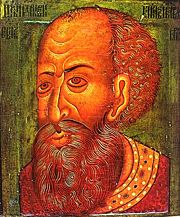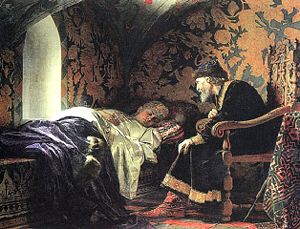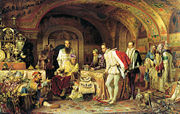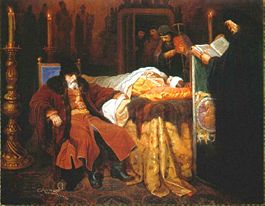Ivan IV of Russia
2008/9 Schools Wikipedia Selection. Related subjects: Historical figures
| Ivan IV Ivan the Terrible |
|
| Grand Prince of Moscow Czar of all Russia |
|
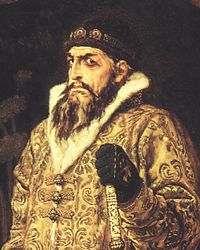 Portrait of Ivan IV by Viktor Vasnetsov, 1897 ( Tretyakov Gallery, Moscow) |
|
| Reign | 3 December 1533 - 28 March [ O.S. 18 March] 1584 |
|---|---|
| Coronation | 16 January 1547 |
| Born | 25 August 1530 |
| Birthplace | Moscow |
| Died | 28 March [ O.S. 18 March] 1584 (aged 53) |
| Place of death | Moscow |
| Predecessor | Vasili III |
| Feodor I | |
| Successor | Feodor I |
| Consort | Anastasia of Russia |
| Offspring | Feodor I |
| Dynasty | Rurik |
| Father | Vasili III |
| Mother | Elena Glinskaya |
Ivan IV Vasilyevich (Russian: Ива́н Четвёртый, Васи́льевич), best known as Ivan the Terrible ( August 25, 1530, Moscow – 28 March [ O.S. 18 March] 1584, Moscow) was Grand Prince of Moscow from 1533.
The Grand Prince Ivan having achieved much overseeing numerous changes in the transition from a mere local medieval nation state to a small empire and emerging regional power, became acknowledged as the first Tsar (or czar) of a new more powerful nation, became "Tsar of All Russia" from 1547.
Ivan was strong minded, devout, and impulsive; given to rages, and according to the suspicions of some, probably had episodic outbreaks of mental disorder. One notable outburst resulted in the death of his groomed and chosen heir—Ivan Ivanovich—resulting in the passing of the Tsardom to a less than ideal younger son—the mentally retarded Feodor I of Russia.
His long reign saw the conquest of the Khanates of Kazan, Astrakhan, and Sibir, transforming Russia into a multiethnic and multiconfessional state. He is traditionally known in Russian as Ivan Grozny (Russian: Ива́н Гро́зный listen ), which is typically translated into English as Ivan the Terrible, but is more correctly translated as Ivan the Threatening.
The Tsardom of Rus' (Russian: Царство Русское) was the official name for the Russian state between Ivan IV's assumption of the title of Tsar (Emperor) in 1547 and Peter the Great's foundation of the Russian Empire in 1721. The name originated from the fact that it contained all of the Rus lands that were at the time free of foreign states domination.
Some Western sources refer to this little known or understood state as Muscovite Russia or Muscovy, the term originally applied in Western and Central Europe to its medieval predecessor, the Grand Duchy of Moscow. Diverse researchers consider the propagation of this term in Western Europe as a result of political interests and active diplomacy of Poland, the strongest international power in Northern-eastern Europe of the dawning Early Modern era.
Early reign
Ivan was the long awaited son of Vasili III, who had divorced his first wife in the 1520s on the grounds that she was barren (he charged her with sorcery and had her forcibly tonsured a nun before marrying Elena Glinskaya, Ivan's mother.) When Ivan was just three years old his father died from a boil and inflammation on his leg which developed into blood poisoning. Ivan was proclaimed the Grand Prince of Moscow at his father’s request. At first, his mother Yelena Glinskaya acted as a regent, but she died when Ivan was merely eight years old. She was replaced as regent by boyars from the Shuisky family until Ivan assumed power in 1544. According to his own letters, Ivan customarily felt neglected and offended by the mighty boyars from the Shuisky and Belsky families. (These traumatic experiences may have contributed to his hatred of the boyars and to his mental instability. Alternatively, the negative feelings revealed in his letters may have been a reflection of his disagreeable temperament.)
Ivan was crowned king with Monomakh's Cap at the Cathedral of the Dormition at age sixteen on January 16, 1547. Despite calamities triggered by the Great Fire of 1547, the early part of his reign was one of peaceful reforms and modernization. Ivan revised the law code (known as the sudebnik), created a standing army (the streltsy), established the Zemsky Sobor or assembly of the land, a public, consensus-building assembly, the council of the nobles (known as the Chosen Council), and confirmed the position of the Church with the Council of the Hundred Chapters, which unified the rituals and ecclesiastical regulations of the entire country. He introduced the local self-management in rural regions, mainly in the Northeast of Russia, populated by the state peasantry. During his reign the first printing press was introduced to Russia (although the first Russian printers Ivan Fedorov and Pyotr Mstislavets had to flee from Moscow to the Grand Duchy of Lithuania).
In 1547 Hans Schlitte, the agent of Ivan, employed handicraftsmen in Germany for work in Russia. However all these handicraftsmen were arrested in Lübeck at the request of Poland and Livonia. The German merchant companies ignored the new port built by Ivan on the river Narva in 1550 and continued to deliver goods in the Baltic ports owned by Livonia. Russia remained isolated from sea trade.
Ivan formed new trading connections, opening up the White Sea and the port of Arkhangelsk to the Muscovy Company of English merchants. In 1552 he defeated the Kazan Khanate, whose armies had repeatedly devastated the Northeast of Russia, and annexed its territory. In 1556, he annexed the Astrakhan Khanate and destroyed the largest slave market on the river Volga. These conquests complicated the migration of the aggressive nomadic hordes from Asia to Europe through Volga and transformed Russia into a multinational and multiconfessional state. He had St. Basil's Cathedral constructed in Moscow to commemorate the seizure of Kazan. Legend has it that he was so impressed with the structure that he had the architect, Postnik Yakovlev, blinded, so that he could never design anything as beautiful again. In fact, it is known that Yakovlev designed several churches and the kremlin walls in Kazan itself in the early 1560s, as well as the chapel over St. Vasilii's grave that was added to St. Basil's Cathedral in 1588, several years after Ivan's death, indicating that he had not, in fact, been blinded by the tsar years earlier.
Other events of this period include the introduction of the first laws restricting the mobility of the peasants, which would eventually lead to serfdom, and change in Ivan's personality, traditionally linked to his near-fatal illness in 1553 and the death of his first wife, Anastasia Romanovna in 1560. Ivan suspected boyars of poisoning his wife and of plotting to replace him on the throne with his cousin, Vladimir of Staritsa. In addition, during that illness Ivan had asked the boyars to swear an oath of allegiance to his eldest son, an infant at the time. Many boyars refused, deeming the tsar's health too hopeless to survive. This angered Ivan and added to his distrust of the boyars. There followed brutal reprisals and assassinations, including those of Metropolitan Philip and Prince Alexander Gorbatyi-Shuisky.
The 1565 formation of the Oprichnina was also significant. The Oprichnina was the section of Russia (mainly the Northeast) directly ruled by Ivan and policed by his personal servicemen, the Oprichniki. This system of Oprichnina has been viewed by some historians as a tool against the omnipotent hereditary nobility of Russia ( boyars) who opposed the absolutist drive of the tsar, while others have interpreted it as a sign of the paranoia and mental deterioration of the tsar.
Later reign
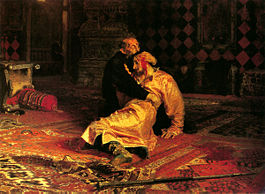
The later half of Ivan's reign was far less successful. Although Khan Devlet I Giray of Crimea repeatedly devastated the Moscow region and even set Moscow on fire in 1571, the Czar supported Yermak's conquest of Tatar Siberia, adopting a policy of empire-building, which led him to launch a victorious war of seaward expansion to the west, only to find himself fighting the Swedes, Lithuanians, Poles, and the Livonian Teutonic Knights.
For twenty-four years the Livonian War dragged on, damaging the Russian economy and military and failing to gain any territory for Russia. In the 1560s the combination of drought and famine, Polish-Lithuanian raids, Tatar invasions, and the sea-trading blockade carried out by the Swedes, Poles and the Hanseatic League devastated Russia. The price of grain increased by a factor of ten. Epidemics of the plague killed 10,000 in Novgorod. In 1570 the plague killed 600-1000 in Moscow daily. One of Ivan's advisors, Prince Andrei Kurbsky, defected to the Lithuanians, headed the Lithuanian troops and devastated the Russian region of Velikiye Luki. This treachery deeply hurt Ivan. As the Oprichnina continued, Ivan became mentally unstable and physically disabled. In one week, he could easily pass from the most depraved orgies to anguished prayers and fasting in a remote northern monastery.
Because he gradually grew unbalanced and violent, the Oprichniks under Malyuta Skuratov soon got out of hand and became murderous thugs. They massacred nobles and peasants, and conscripted men to fight the war in Livonia. Depopulation and famine ensued. What had been by far the richest area of Russia became the poorest. In a dispute with the wealthy city of Novgorod, Ivan ordered the Oprichniks to murder inhabitants of this city, which was never to regain its former prosperity. His followers burned and pillaged the city and villages. As many as 60,000 might have been killed during the infamous Massacre of Novgorod in 1570; many others were deported elsewhere. Yet the official death toll named 1,500 of Novgorod big people (nobility) and only mentioned about the same number of smaller people. Many modern researchers estimate number of victims between two and three thousand. (After the famine and epidemics of 1560s the population of Novgorod perhaps did not exceed 10,000-20,000.)
Having rejected peace proposals from his enemies, Ivan IV found himself in a difficult position by 1579, when Crimean Khanate devastated Muscovian territories and even burnt down Moscow (see Russo-Crimean Wars). The dislocations in population fleeing the war compounded the effects of the concurrently occurring drought and exacerbated war engendered epidemics causing much loss of population.
All together, the prolonged war had near fatally affected the economy, Oprichnina had thoroughly disrupted the government, while The Grand Principality of Lithuania had united with The Kingdom of Poland and acquired an energetic leader, Stefan Batory, who was supported by Russia's southern enemy, The Ottoman Empire ( 1576). Ivan's realm was now squeezed by two great powers of the day.
With the failure of negotiations, Stefan Batory replied with a series of three offensives against Muscovy in each campaign seasons of 1579–1581, trying to cut The Kingdom of Livonia from Muscovian territories.
During his first offensive in 1579 with 22,000 men he retook Polotsk, during the second, in 1580, with 29,000-strong army he took Velikie Luki, and in 1581 with a 100,000-strong army he started the Siege of Pskov.
Frederick II had trouble continuing the fight against Muscovy unlike Sweden and Poland. He came to an agreement with John III in 1580 giving him the titles in Livonia. That war would last from 1577 to 1582. Muscovy recognized Polish-Lithuanian control of Ducatus Ultradunensis only in 1582. After Magnus von Lyffland died in 1583, Poland invaded his territories in The Duchy of Courland and Frederick II decided to sell his rights of inheritance. Except for the island of Œsel, Denmark was out of the Baltic by 1585. As of 1598 Inflanty was divided onto:
- Wenden Voivodeship (województwo wendeńskie, Kieś)
- Dorpat Voivodeship (województwo dorpackie, Dorpat)
- Parnawa Voivodeship (województwo parnawskie, Parnawa)
In 1581, Ivan beat his pregnant daughter-in-law for wearing immodest clothing, which may have caused a miscarriage. His son, also named Ivan, upon learning of this, engaged in a heated argument with his father, which resulted in Ivan striking his son in the head with his pointed staff, causing his son's (accidental) death. This event is depicted in the famous painting by Ilya Repin, Ivan the Terrible and his son Ivan on Friday, November 16, 1581 better known as Ivan the Terrible killing his son.
Death and legacy
Although it is thought by many that Ivan died while setting up a chess board, it is more likely that he died while playing chess with Bogdan Belsky on March 18, 1584. When Ivan's tomb was opened during renovations in the 1960s, his remains were examined and discovered to contain very high amounts of mercury, indicating a high probability that he was poisoned. Modern suspicion falls on his advisors Belsky and Boris Godunov (who became tsar in 1598). Three days earlier, Ivan had allegedly attempted to rape Irina, Godunov's sister and Feodor's wife. Her cries attracted Godunov and Belsky to the noise, whereupon Ivan let Irina go, but Belsky and Godunov considered themselves marked for death. The tradition says that they either poisoned or strangled Ivan in fear for their own lives. The mercury found in Ivan's remains may also be related to treatment for syphilis, which it is speculated that Ivan had. This same investigation revealed that Ivan had also suffered many years from rheumatoid arthritis, which also was treated with mercurials. It is well known that one of the end stages of syphilis (Tertiary Syphilis) many times results in severe disseminated arthritis. Not only can heavy metal (mercury) poisoning lead to violent mood swings, but so does Tertiary Syphilis. Upon Ivan's death, the ravaged kingdom was left to his unfit and childless son Feodor.
Epistles
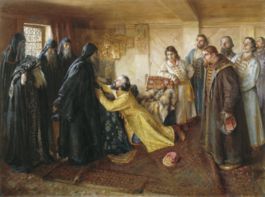
D.S. Mirsky called Ivan "a pamphleteer of genius". The epistles attributed to him are the masterpieces of old Russian (perhaps all Russian) political journalism. They may be too full of texts from the Scriptures and the Fathers, and their Church Slavonic is not always correct. But they are full of cruel irony, expressed in pointedly forcible terms.
The shameless bully and the great polemicist are seen together in a flash when he taunts the runaway prince Kurbsky with the question: "If you are so sure of your righteousness, why did you run away and not prefer martyrdom at my hands?" Such strokes were well calculated to drive his correspondent into a rage. "The part of the cruel tyrant elaborately upbraiding an escaped victim while he continues torturing those in his reach may be detestable, but Ivan plays it with truly Shakespearian breadth of imagination". These letters are often the only source we have on Ivan's personality and provide crucial information on his reign, but Harvard professor Edward Keenan has argued that these letters are seventeenth century forgeries. This contention, however, has not been widely accepted, and other scholars, such as John Fennell and Ruslan Skrynnikov continued to argue for their authenticity. Recent archival discoveries of sixteenth century copies of the letters strengthen the argument for their authenticity.
Besides his letters to Kurbsky he wrote other satirical invectives to men in his power. The best is his letter to the abbot of the Kirillo-Belozersky Monastery, where he pours out all the poison of his grim irony on the unascetic life of the boyars, shorn monks, and those exiled by his order. His picture of their luxurious life in the citadel of ascetism is a masterpiece of trenchant sarcasm.
Sobriquet
The English word terrible is usually used to translate the Russian word grozny in Ivan's nickname, but the modern English usage of terrible, with a pejorative connotation of bad or evil, does not precisely represent the intended meaning. Grozny's meaning is closer to the original usage of terrible—inspiring fear or terror, dangerous (as in Old English in one's danger), formidable, threatening, or awesome. Perhaps a translation closer to the intended sense would be Ivan the Fearsome, or Ivan the Formidable.
| Preceded by Vasili III |
Grand Prince of Moscow 1533–1547 |
Succeeded by became Tsar |
| Preceded by None |
Tsar of Russia 1547–1584 |
Succeeded by Feodor I |
| Preceded by Yury |
Heir to the Russian Throne 1530–1533 |
Succeeded by Yuri Vasilyevich |
